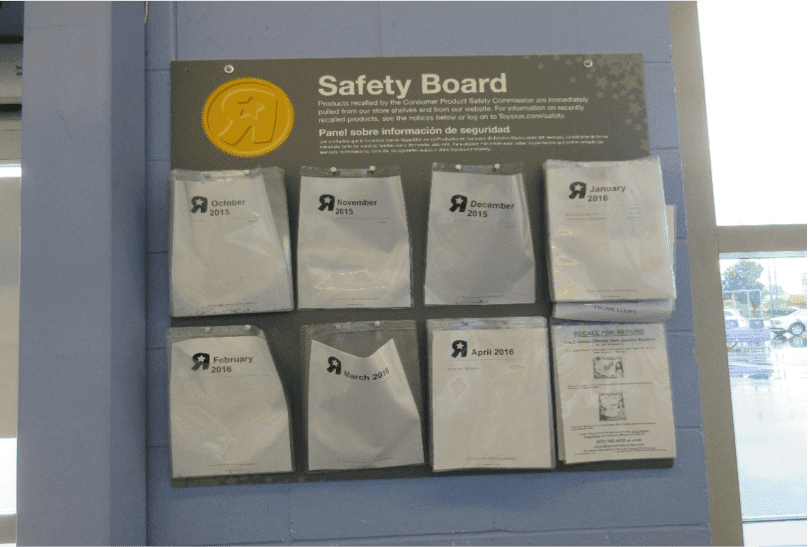This post was contributed to ConsumerSafety.org by former Consumer Product Safety Commission Inspector Doug Pinheiro. It is the third of a three-part series on recalls, the first two parts being on identifying a problem and evaluating the severity of the issue.
Anatomy of a Recall Part 3: Spreading the Word

Previously, I demonstrated how potentially hazardous products come to the attention of CPSC and how they are evaluated. In the event that CPSC determines that a product is not compliant with existing federal safety standards or presents a substantial product hazard, the next step is to initiate a product recall.
The goal of any recall is to effectively locate all noncomplying products, remove noncomplying products from the distribution chain and from the possession of consumers, and to communicate the recall, the hazard, and the corrective action to the public.
The responsible firm is notified by CPSC via a letter of advice of the hazard, request stop sale and distribution of the subject product and will contain corrective actions to address the hazard or violation. The recalling firm first needs to quarantine and segregate all recalled product throughout the distribution chain. The web of commerce is intricate, so this could affect a manufacturer, retailer, repackager, importer, distributor or wholesaler.
CPSC works closely with the recalling firm to agree on, implement, and communicate appropriate corrective actions. The CPSC and firms have a common interest in safety. Firms also have their reputations to consider; no firm wants to be the headline of a costly major product recall, especially if it becomes a recurring theme.
Recall News Releases
This is the official announcement of a recall by CPSC and is issued jointly with the recalling firm. The word "recall" must be in the heading and it must start with "In cooperation with the U.S. Consumer Product Safety Commission...." The release must contain a myriad of very specific information, so I will narrow it down to the key items.
The release, which is posted on CPSC's website, must include:
- Recalling firm's legal and commonly known trade name, location and headquarters
Manufacturer of the recalled product. If manufactured outside the US, identity of the importer - All significant retailers, by commonly known trade name, of the product (e.g., Wal-Mart, Target, etc.)
- The number of product units covered by the recall
- Full description of the product, to include colors, sizes, model numbers, date codes, SKUs, tracking numbers, production dates, retail sales dates, retail price range, and color digital images depicting identifying features
- Description of the products actual or potential hazards giving rise to the recall, including product defect and type of hazard/risk (e.g., laceration, burn, entrapment, etc.)
- A summary of incidents giving rise to the recall, including a number of incidents, any resulting property damage, injuries, and deaths
- A toll-free hotline number, website address, and a URL to the recall news release on the firm's website
- Complete recall instructions for the consumer to follow that will motivate the consumer to take advantage of the remedy (yes, not all consumers pay attention to recalls).
The news releases are sent to national wire services, major newspapers, television and radio networks, and consumers subscribed to CPSC's recall notification service. All recall news releases can be found on CPSC's website.
Video News Releases
A video news release is a taped version of the written release. It may include statements from company officials or the CPSC Chairman. This method is usually employed for high profile recalls such as the recent Samsung Galaxy Note 7 phone recall. CPSC Chairman Elliot Kaye announced this recall on national television.
Point-of-Purchase Posters
Posters are an effective means of keeping recalls in the spotlight after the initial recall announcement. They contain much of the same information as the news release. The recalling firm produces the posters and they must be approved by CPSC prior to printing and distribution to the stores selling the recalled product.
Posters must be displayed in conspicuous locations in the stores or offices where customers will see them. This could be entrance ways, safety bulletin boards, near the checkouts and the area of the retail floor where the product was originally displayed. They must be displayed for a period of 120 days.

Safety bulletin board at a big box store
Registration/Warranty Cards
More expensive products are usually accompanied by registration and/or warranty cards that behoove the buyer to fill out and send in. These are kept on file and the recalling firm can notify past customers of the recall, so do not throw them away.
Social Media
When the CPSC was first formed in 1972, there was no internet, email, websites or social media. CPSC had to rely on the traditional methods of notification as described above, which were not always as successful as intended.
Social media presents a whole new communication platform that just about everybody participates in. Firms should notify their customers, and consumers as a whole, by using all available social media and mobile platforms including firm Facebook, Google+ pages, Twitter accounts, YouTube accounts, Pinterest, Instagram, Flickr, and company blogging networks in order to get as broad a notice as possible.
All of the above notification methods are negotiated with the firm prior to the recall announcement as part of the CPSC approved corrective action plan.
Monitoring Recalled Products
This is the final stage in the recall process. No recall is 100% effective, but the obvious theory is the more effective the recall, the fewer incidents that occur. Also, note that it is illegal for any person or firm to distribute recalled product in commerce.
Monitoring includes four major components as follows:
- Submission of monthly progress reports to CPSC to include the total number of recalled products entered into commerce, number of products retrofitted, repaired or returned (depending on recall protocol), the number of customers notified, and any post recall incidents or injuries.
- Recall verification firm inspections conducted by field investigators to monitor the implementation of the corrective action plan.
- Retail visits conducted by field investigators to confirm receipt of recall notification and posters, that the point of purchase posters are conspicuously posted and to verify recalled products have been quarantined and no longer being sold.
- If a recalling firm requests to dispose or destroy recalled inventory, a field investigator will witness and document said disposal or destruction.
Fast Track Product Recall Program
In 1995, CPSC established the fast track program to expedite recalls. This program can be used by firms that self-report potential product defects as described in part 1 on this article.
In this scenario, the firm agrees to implement, in conjunction with CPSC, a consumer-level voluntary recall. This negates the need for CPSC to conduct a preliminary determination as to whether the product contains a defect which creates a substantial product hazard.
This is a win-win situation, as the reporting firm and CPSC can immediately start work on a corrective action program. The beauty of this program is that CPSC does not need to devote resources and time to investigate the reported defect, which dramatically expedites the time needed to initiate a recall and inform the consuming public.
In conclusion, these are the basic steps of a consumer product recall. More detailed information is available in the Recall Handbook and Regulated Products Handbook, both available at www.cpsc.gov.
Most people think of government agencies as large bureaucratic behemoths, but the CPSC is a very small, resource-driven, independent federal regulatory agency with only about 500 employees, 100 of which are field investigators and far fewer are compliance staff. It's a big job for a small agency, which makes it one of the most cost-effective in the U.S. government.
